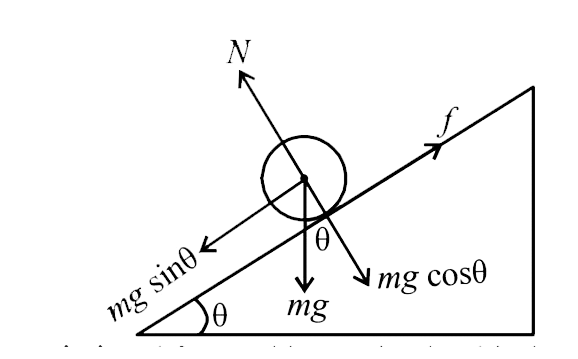Question
Question: The rolling object rolls without slipping down an incline plane (angle of inclination \[\theta \]), ...
The rolling object rolls without slipping down an incline plane (angle of inclination θ), then the minimum acceleration it can have is:
(A) gsinθ
(B) 32gsinθ
(C) 2gsinθ
(D) zero
Solution
We will first apply Newton’s laws of motion to calculate acceleration on an inclined plane for pure rolling. We can also directly use the formula for acceleration: -
a=1+mR2Igsinθ
Where,
a = acceleration of the rolling body on the incline. (pure rolling)
θ = inclination of the plane from horizontal.
g = acceleration due to gravity.
I = moment of inertia of the body about its centre of mass.
R = radius of the rolling body.
After calculating this acceleration, we will check for its minimum possible value.
Complete step by step solution
__
Figure 1/Pure Rolling on an inclined Plane
We will apply Newton’s Law of motion along the incline: -
∑F=ma
Where,
∑F= Net Force acting on the body.
M = mass of the body.
a = acceleration of the body in the direction of force.
mgsinθ−f=ma . . . (1)
We will apply newton’s Law for rotational mechanics: -
∑τ=Iα
Where,
∑τ = Net Torque acting on the body.
I = Inertia of the body about centre of mass.
α = Angular Acceleration of the body.
f×R=I×Ra (using a=αR )
f=R2Ia . . . (2)
Adding (1) and (2) we get: -
mgsinθ=ma+R2Ia
gsinθ=a+mR2Ia
gsinθ=a(1+mR2I)
⇒a=1+mR2Igsinθ
Now, in the above formula we see that acceleration will be minimum when the denominator = 1+mR2I will be maximum. The denominator will be maximum for the maximum value of I.
I have its maximum possible value for a ring which is ‘mR2’. Thus, we take I=mR2 .
Now, acceleration becomes: -
a=1+mR2mR2gsinθ
a=1+1gsinθ
⇒a=2gsinθ
Hence, option(c) is correct.
Note
(A) In the above question, it is stated that the object rolls without slipping. This is the case for pure rolling. Hence, frictional force will be self-adjusting and not equal to maximum value of friction, that is, μsN . Thus, do not keep f = μsN in the above question to calculate acceleration using eq-(1).
(B) However, this is exactly what is done to calculate acceleration when the rolling motion is not pure. In that case, acceleration is given by the following equation: -
a=gsinθ−μkcosθ (for impure rolling motion)
(C) Also, remember that the relation: - “ a=αR ” is only valid in case of pure rolling motion and that is why we were able to use this relation in the above question.
